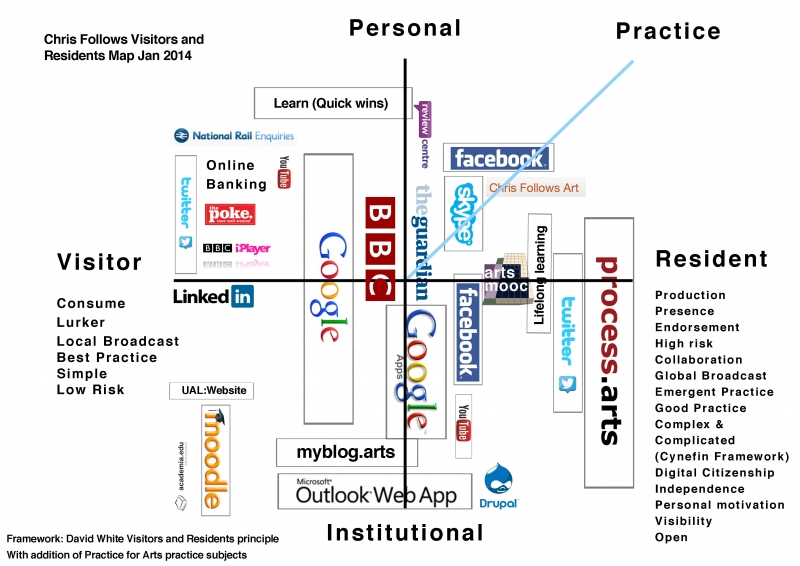Bring Your Own Environment BYOE
People like to do things their own way and when it comes to being online the same can apply. There are plenty of ways to get online some easy and some not so easy, making an informed choice based on your long term needs could make a huge difference to how your online environment, life, presence and practice evolves over time.
There are a number of personal/professional reasons for being online and our choice of online environment/s can be an important long term decision, from:
- Social media
- The readymade one click, out the box solution, 'tied in' proprietary packages
- DIY hands and demanding webmaking, code & open source route.
Whichever we choose understanding the benefits, negatives and challenges and getting to grips with creating your own online environment can be difficult and can an ongoing, long term iterative process.
The BYOE interest group aims to explore the growing need for individuals and groups to build, develop and manage their own collaborative online environments. The project supports independent approach to building communities online and will explore how we can also integrate and capitalise on wider connections with other related independent networks. Please contact Chris c.follows if you would like to be part of the BYOE interest group.
The all in one site approach
Process.arts has been exploring different ways to support individuals and groups to build creative group networks for the past 6 years on a single site. Process.arts provides a quick and easy way to set up and start an instant group environment e.g. learning groups (Example), projects (Example) and many other sharing networks please see this case study and these groups on process.arts. Process.arts provides a useful starter environment and vehicle towards creating an online group environment.
Understanding your online environment
A good example of this journey is well illustrated in David White’s the ‘Visitors and Residents’ mapping process also see What exactly are your students up to online?. As we move along the visitor and residence continuum we make best use of commercial and institutional/VLE software that is offered to us e.g easy to use or must be used as part of job/VLE or life/online banking. If then BYOE comes into the mix your map becomes a lot more complex as you manage the use of multiple environments those environments you have to use and those you want to use.
Also see:
Visitors and Residents New forms of practice and the challenges of Residency on the web
Videos
A series of videos produced by David White of Oxford University explaining the Visitors and Residents model.
Find out more about Netskills' work on Visitors & Residents
Workshop: Are you an online Visitor or Resident?
A practical workshop using the Visitor or Resident model to help participants explore and enhance their online practice. The workshop is supported by a series of online follow-up sessions to support participants in carrying out real- world, experiential activities in new forms of practice.
Some V&R map examples:
| BYOE Visitor and Residence map | Visitor and Residence map |
 |
 |
Try your own map out ?
| V & R Blank map | V & R Map with additional practice |
 |
 |
The BYOE approach
BYOE may apply to those who want to go it alone after some time working in collaborative ready made and supported environments like process.arts, either way it may be helpful to have some proof of concept or experience of testing your needs in other environments before taking the fully independent leap into BYOE. The V&R mapping process provides a very useful way to help us visualise our online environment in all contexts. As an individual moves towards the resident end on the continuum (personal, practice and professional) we can see the need for the BYOE, individuals will move between the formal institutional VLE tools offered by universities and use their BYOE to develop their personal and professional online presence, we will fill in the gaps ourselves.
BYOE requires some experience and commitment in online engagement, there are many vital things to consider before starting this journey, this project aims to explore these challenges, please see some links below to get started:
Have we the right balance between open education and commercial social media?
Talking about online and offline Communities of Practice for the Creative Online Identities course
Online Identities Pilot Programme
| Attachment | Size |
|---|---|
| bring_your_own_environment_byoe.jpg | 172.19 KB |
| chris_follows_visitors_and_residents_map_18-01-13.jpg | 656.12 KB |
| visitors_and_residents_practice_-_additional_practice_.jpg | 786.75 KB |
| visitors_and_residents_map_blank_.jpg | 693.15 KB |

This Work, Bring Your Own Environment BYOE, by cfollows is licensed under a Creative Commons Attribution-ShareAlike 4.0 International license.



Comments
The internet mapping project - http://kk.org/internet-mapping/
Visitors and Residents InfoKit - Evaluating digital services: a Visitors and Residents approach - http://www.jiscinfonet.ac.uk/infokits/evaluating-services/